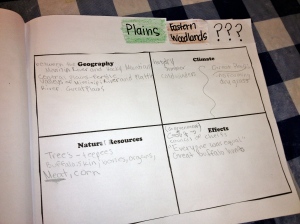

This year my partner teacher and I are really striving to pull the essential questions and desired comprehension skills we want students to achieve BEFORE we plan the unit or chapter. Chapter 2 of our social studies book is Native Americans and the different regions in the U.S. The big idea is that people need to use their environment to survive and that affects their lifestyle. Our HM comprehension skill for the week was also “drawing conclusions”. This is what we came up with. (It turned out well. Next year, I would make only a few minor adjustments.)
We had the students make a tab book for Lessons 1-4. Next year, I would include one for Lesson 5 “The Arctic”, but to be honest I ran out of time. I used the last page as their quiz/assessment. It’s designated with question marks. Each page has the same 4 quadrant grid with geography, climate, natural resources, and effects. (I actually already changed the “effects” to daily lifestyle because I believe it fits better and makes more sense to the students. They need to gather all information before they can make any sort of reasonable conclusion.) This helps in the reading instruction because I can focus on pulling only the main idea and important facts/details for each section of the grid.
I used the book as a resource along with books from our school library and videos from discovery education (about 15 min. long per region.) The first two lessons we completed as a class. The next one was completed with partners and the final grid was completed individually to determine if the students could search their text for all the necessary information. We color coded each tab to match the region of the map on the front cover. 


The last page has 3 questions that students will not be able to find the answers directly in the text. They must use evidence from the text to support their conclusions, but have to come up with their own answers from everything we had learned and discussed in the past weeks. From the assessments, I have a very good idea of where my instruction needs to go next…which is a good thing.

And finally, after all this gathering of information, we felt the students were missing some of the beautiful, cultural aspects of these people so we had the students read myths and legends during our language arts instruction in reading groups AND make their own dreamcatchers. I found simple instructions online and materials needed were: paint, paper plates, yarn, and feathers. The students loved it! I had them paint the plates Friday morning so by the afternoon, we could decorate. We read a short passage on dreamcatchers before we began and played some tribal flute music during the rest of the lesson.
I’ll add pictures of my finished board later…forgot to snap it before I left. Click here for the entire document-Native American Tab Book







